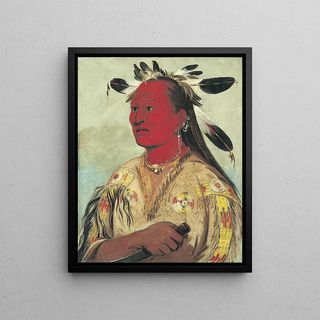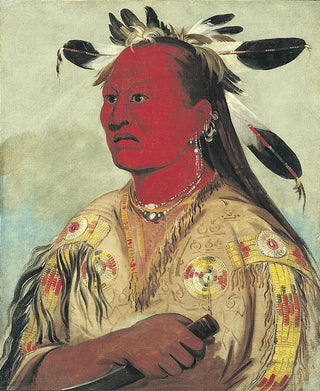Art print | Stnaupat Main Sanglante Chef de la Tribu - George Catlin


View from behind

Frame (optional)
George Catlin’s art print of the Bloody Hand Stnaupat Chief of the Tribe is a work that immerses the viewer in the rich and complex universe of Native American cultures. Created in the 19th century, this painting embodies not only the exceptional talent of its creator but also a pivotal moment in history when indigenous traditions began to be threatened by colonial expansion. As an artist and observer, Catlin captured the essence of his subjects with a depth and sensitivity that transcend time. This artwork, depicting a tribal chief with a proud and determined gaze, evokes a story of resistance and dignity that still resonates today.
Style and uniqueness of the work
Catlin’s style is distinguished by its meticulous attention to detail and vibrant color palette. In "Stnaupat Main Sanglante Chief of the Tribe," the features of the chief’s face are rendered with remarkable precision, each shadow and light contributing to a majestic yet intimate atmosphere. The composition is carefully balanced, highlighting the imposing stature of the figure while incorporating symbolic elements of his culture. Traditional ornaments, such as feathers and body paint, are depicted with striking realism, reflecting the respect Catlin had for his subjects. This art print does not merely depict an individual; it tells a collective story, that of a people whose identity is at stake.
The artist and his influence
George Catlin, born in 1796, is often regarded as one of the first artists to dedicate his career to representing Native American cultures. Traveling across the United States, he documented tribes and traditions that were then little known to the general public. His work is marked by a desire to preserve a cultural heritage in danger, and the art print of the Bloody Hand Stnaupat Chief of the Tribe is a perfect example. Catlin not only contributed to the recognition of indigenous peoples in the art world but also sparked interest in their history and struggles. His empathetic and respectful approach has

Matte finish

View from behind

Frame (optional)
George Catlin’s art print of the Bloody Hand Stnaupat Chief of the Tribe is a work that immerses the viewer in the rich and complex universe of Native American cultures. Created in the 19th century, this painting embodies not only the exceptional talent of its creator but also a pivotal moment in history when indigenous traditions began to be threatened by colonial expansion. As an artist and observer, Catlin captured the essence of his subjects with a depth and sensitivity that transcend time. This artwork, depicting a tribal chief with a proud and determined gaze, evokes a story of resistance and dignity that still resonates today.
Style and uniqueness of the work
Catlin’s style is distinguished by its meticulous attention to detail and vibrant color palette. In "Stnaupat Main Sanglante Chief of the Tribe," the features of the chief’s face are rendered with remarkable precision, each shadow and light contributing to a majestic yet intimate atmosphere. The composition is carefully balanced, highlighting the imposing stature of the figure while incorporating symbolic elements of his culture. Traditional ornaments, such as feathers and body paint, are depicted with striking realism, reflecting the respect Catlin had for his subjects. This art print does not merely depict an individual; it tells a collective story, that of a people whose identity is at stake.
The artist and his influence
George Catlin, born in 1796, is often regarded as one of the first artists to dedicate his career to representing Native American cultures. Traveling across the United States, he documented tribes and traditions that were then little known to the general public. His work is marked by a desire to preserve a cultural heritage in danger, and the art print of the Bloody Hand Stnaupat Chief of the Tribe is a perfect example. Catlin not only contributed to the recognition of indigenous peoples in the art world but also sparked interest in their history and struggles. His empathetic and respectful approach has






